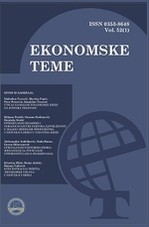Economic Themes (2024) 62 (3) 8, 413-428
Vesna Martin
Abstract: The purpose of this paper is to examine how, using Serbia as an example, climate change impacts financial stability. Our sectoral analysis approach will be used to demonstrate if transition risk has an impact on climate change. Based on Serbian data, we identified that the mining sector generates the highest level of pollution. Since a sizable portion of domestic banks' loans are allocated to the mining industry, this industry is crucial for the development of banks' risk profiles with regard to the risk of climate change in the context of the shift to a green economy. From the perspective of financial stability, it is necessary to determine whether the credit activity of the mining sector is sustainable. For this purpose, we will use a one-sided Hodrick-Prescott (HP) filter and set the value of the parameter λ to 1,600 to calculate the long-term trend of the share of real mining credit in the real gross domestic product. If the ratio of real loans to real GDP is at least two percentage points above its long-term trend and the rate of credit growth does not promote economic expansion, then credit growth is seen to be excessive. The analysis findings revealed that between the third quarters of 2010 and the fourth quarter of 2022, when the analysis was conducted, there was a gap between the real mining loans and the real gross domestic product less than 2 percentage points. Based on the results that have been presented, we may conclude that lending to the mining sector does not now constitute a threat to financial stability.
Keywords: financial stability; climate change risks; mining industry; economic consequences; role of central banks; green transition
THE IMPACT OF CLIMATE CHANGE ON THE FINANCIAL STABILITY OF THE REPUBLIC OF SERBIA: THE CASE OF THE MINING INDUSTRY
Vesna Martin
Abstract: The purpose of this paper is to examine how, using Serbia as an example, climate change impacts financial stability. Our sectoral analysis approach will be used to demonstrate if transition risk has an impact on climate change. Based on Serbian data, we identified that the mining sector generates the highest level of pollution. Since a sizable portion of domestic banks' loans are allocated to the mining industry, this industry is crucial for the development of banks' risk profiles with regard to the risk of climate change in the context of the shift to a green economy. From the perspective of financial stability, it is necessary to determine whether the credit activity of the mining sector is sustainable. For this purpose, we will use a one-sided Hodrick-Prescott (HP) filter and set the value of the parameter λ to 1,600 to calculate the long-term trend of the share of real mining credit in the real gross domestic product. If the ratio of real loans to real GDP is at least two percentage points above its long-term trend and the rate of credit growth does not promote economic expansion, then credit growth is seen to be excessive. The analysis findings revealed that between the third quarters of 2010 and the fourth quarter of 2022, when the analysis was conducted, there was a gap between the real mining loans and the real gross domestic product less than 2 percentage points. Based on the results that have been presented, we may conclude that lending to the mining sector does not now constitute a threat to financial stability.
Keywords: financial stability; climate change risks; mining industry; economic consequences; role of central banks; green transition

